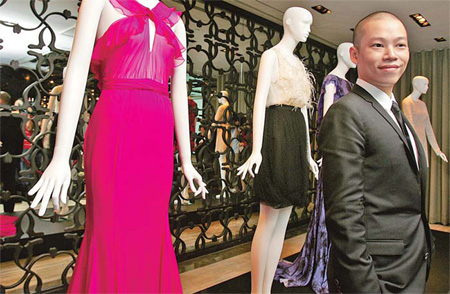Society
East in vogue as US puts on the style for export
By Kelly Chung Dawson (China Daily)
Updated: 2010-10-29 07:54
 |
Large Medium Small |
|
Jason Wu stands in front of his collection at a media event during his homecoming tour on Oct 7 in Taipei, Taiwan. [Chiang Ying-ying / AP] |
Going east
As global financial markets have faltered in recent years, Western brands have increasingly been turning to developing markets, such as China and India.
"This change of cultural emphasis has created more opportunities not just for Chinese Americans but Chinese fashion designers as a whole," said Kin Yeung, founder of Blanc de Chine, a Chinese fashion house.
Asian designers who spotted the opportunities are already attempting to expand their markets in the Far East.
Award-winner Wu, who was raised in Taiwan and designed the dress Michelle Obama wore to her husband Barack's inauguration as the 44th US president, teamed up with luxury retail store Lane Crawford in 2009 and is now focusing on international expansion in South Korea, Japan and Singapore.
He also recently announced a partnership with Shiseido, the hugely popular Japanese hair care and cosmetics brand.
"I am proud of and grateful for my Chinese heritage," Wu told China Daily. "It seemed like a natural step to expand in the Asian market in a big way."
Derek Lam's clothing is sold in the luxurious Joyce Boutique in Hong Kong, while he also serves as a creative director for Tod's, the Italian shoemaker. Jan Schlottman, chief executive of Derek Lam International, credited both factors with helping the American-born Chinese designer to raise his profile in Asia, especially China.
"With international fashion trends becoming more accessible to Chinese audiences, they've learned to express their personal style through what they wear," said Schlottman. "Within this search we see an opportunity to enter the next generation of brands."
Some fashion observers have questioned whether Asian-American designers targeting China will face problems marketing in a country that has long valued the prestige of European luxury brands manufactured overseas.
However, Collins at Parsons argues that things are changing. "There is a consideration that certain foreign elements have always been more desirable but there is beginning to be a ready openness to embrace Chinese design," he said.
It will be a long time before Chinese brands achieve the same level of prestige as the likes of Louis Vuitton, he said, "but previously those who could afford luxury only desired the credibility of overseas brands, whereas now people are more open".
To attain international prominence, however, Collins suggests Chinese designers avoid branding their companies as strictly Chinese, citing the example of Ports 1961. Although not designed by Chinese, it is a Chinese-owned brand that has remained ethnically ambiguous on the international stage, he said.
Regardless, Schlottman said he believes Lam's Chinese background is a marketing asset.
"As a successful Asian-American fashion designer of Chinese descent, Derek elicits a sense of pride in the Chinese people," he said. "It helps make the brand more approachable in the Chinese market."
Yet, others argue that shoppers are unlikely to buy clothes simply because they were made by Asian designers.
"It's all about good design," said Angel Ho, a Hong Kong-born student at Pratt Institute, another famous New York design school. "If it happens to be an Asian designer, that's cool, (people) will find pride in it. But it's not the main selling point."
Still, the majority of the clothing designed by Lam and Wu is actually manufactured outside of China, partly as a calculated move to avoid the stigma occasionally associated with Chinese manufacturing.
Gurung said that having a "made in New York" line has helped him break into the Asian market.
"There has definitely been more openness to my brand because we're made in the US," he said. "It creates a different story; it gives me a global point of view. It's not that I'm closed to the idea of things being made in China - but for now New York is my base and forms the core of my branding."
These factors may change as Chinese companies race to improve quality, said Schlottman. "A renewed sense of pride can be seen in their work as they become competitive in the international market," he said of the Chinese manufacturers who produce roughly 20 percent of Lam's inventory.
